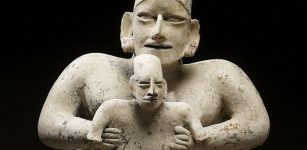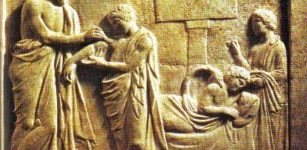Hammurabi: Great King Of Babylon And His Code Of Justice
A. Sutherland - AncientPages.com - Ancient Babylon was home to some powerful dynasties and rulers.
Hammurabi. Image credit: Windu1789 - CC BY-SA 4.0
One of them was Hammurabi, the sixth king in the Babylonian dynasty, who ruled in central Mesopotamia (modern Iraq) from 1792 to 1750 BC.
Who Was This Great King Of Babylon?
First, he proclaimed one of the earliest and most complete ancient legal codes but also contributed much more.
Hammurabi ("Hammu" means "family" in Amorite, and "rapi" means "great" in Akkadian) was one of the most significant historical figures of antiquity; he was a builder, conqueror, and lawmaker.
Ancient sources say that he built up Babylon until it was more powerful than Ur or any other city of its time and made the town the religious center.
Marduk, son of Enki, was declared Babylon's god and the greatest of all the gods, which gave him power and authority to relieve his father of his rank as chief god. Despite many protests, it happened according to Hammurabi's decision.
At the time Hammurabi ascended to the throne, Babylon was already a great state, which included, among others, Kish, Sippar, and Borsippa; however, Hammurabi recognized the authority of Shamshi-Adad I, king of Assyria and Mari, at that time. In the 30th year of his reign, he expanded his kingdom by conquering Larsa, Eshnunna, Assyria, and Mari. For the first time since the Third Dynasty of Ur, he created a powerful Babylonian Empire.
While involved in military and political advances, he also supervised his irrigation projects and the construction of fortifications and temples celebrating Babylon's patron deity, Marduk. Building spectacular pyramids, temples, and towers was difficult because there was no stone in Babylonia.
The Statue of Marduk depicted on a cylinder seal of the 9th century BC Babylonian king Marduk-zakir-shumi I. Detailed info, from Schaudig (2008). Image credit: Franz Heinrich Weißbach - Public Domain
According to Hammurabi's ingenious designs, the impressive structures of Babylon were built of bricks by molding and baking the clay, which hardened into bricks with perfect quality that has survived until today.
At its peak, Babylon, a trade and cultural center, was inhabited by about 200,000 people; at the center of this gigantic city with towers, palaces, and gardens, there was a vast ziggurat, estimated to be about 300 feet tall, according to archaeologists.
The splendid reign of Hammurabi lasted fifty−five years. After his death, great Babylon gradually declined.
The extent of the Babylonian Empire at the start and end of Hammurabi's reign, located in what today is modern-day Kuwait and Iraq. Image credit: MapMaster - CC BY-SA 4.0
Not much is left after Hammurabi's spectacular Babylon; no archives survived, and the only reliable historical documents that tell stories about Babylon are clay tablets unearthed at other locations.
Code Of Hammurabi
One of Hammurabi's most famous achievements is his law code (influenced mainly by Sumerian culture), which included many harsh punishments.
His Code, discovered in 1901, proclaimed at the end of Hammurabi's reign and supporting the doctrine of 'an eye for an eye' – is a collection of 282 laws and standards, indispensable rules for commercial interactions and punishments to meet the requirements of justice.
The black stone stele containing Hammurabi's Code was made from a single, four-ton slab of diorite, a durable but difficult to carve.
At its top is a two-and-a-half-foot relief carving of a standing Hammurabi receiving the law— symbolized by a measuring rod and tape—from the seated Shamash, the Babylonian god of justice.
Hammurabi’s Code. The prologue of the Code of Hammurabi (the 305 first inscribed squares on the stele). Some gaps in the list of benefits bestowed on cities recently annexed by Hammurabi may prove the tablet is older than the celebrated basalt stele (also in the Louvre). Image credit: Unknown artist - Louvre Museum
The rest of the seven-foot-five-inch monument is covered with columns of chiseled cuneiform script.
Hammurabi's Code was looted by later invaders and rediscovered in 1901 by a French archaeological team in present-day Iran.
The Code's 282 edicts – from family law to professional contracts and administrative law – are all written in 'if-then form. The edicts outline different standards of justice for the three classes of Babylonian society – the propertied class, freedmen, and enslaved people. A doctor's fee for curing a severe wound would be ten silver shekels for a gentleman, 5 shekels for a freedman, and two for an enslaved person.
Penalties for malpractice followed the same scheme: a doctor who killed a wealthy patient would have his hands cut off, while only financial restitution was required if the victim was enslaved.
Hammurabi's Code was not the earliest collection of laws, but his version became the most complete and famous in human history.![]()
Written by – A. Sutherland AncientPages.com Staff Writer
Updated on March 24, 2024
Copyright © AncientPages.com All rights reserved. This material may not be published, broadcast, rewritten or redistributed in whole or part without the express written permission of AncientPages.com
Expand for referencesReferences:
Goodspeed, G. S. A History of the Babylonians and Assyrians
Kriwaczek, P. Babylon: Mesopotamia and the Birth of Civilization
Charles River Editors. Babylon
More From Ancient Pages
-
 5th-Century Tomb With Finds Of Historical And Artistic Value Discovered In Eastern Bohemia
Archaeology | Mar 8, 2021
5th-Century Tomb With Finds Of Historical And Artistic Value Discovered In Eastern Bohemia
Archaeology | Mar 8, 2021 -
 What Was On The Menu For Stonehenge’s Builders, 2500 BC? Milk, Yoghurt And Cheese Only Eaten In Exclusive Ceremonies
Archaeology | Oct 14, 2015
What Was On The Menu For Stonehenge’s Builders, 2500 BC? Milk, Yoghurt And Cheese Only Eaten In Exclusive Ceremonies
Archaeology | Oct 14, 2015 -
 Child’s Play: Are Tibetan Hand And Foot Traces The Earliest Example Of Parietal Art?
Archaeology | Sep 18, 2021
Child’s Play: Are Tibetan Hand And Foot Traces The Earliest Example Of Parietal Art?
Archaeology | Sep 18, 2021 -
 Biblical Lydia ‘Woman Of Purple’ Who Run Her Own Business
Biblical Mysteries | Apr 9, 2019
Biblical Lydia ‘Woman Of Purple’ Who Run Her Own Business
Biblical Mysteries | Apr 9, 2019 -
 Fossilized Remains Of A Gigantic Jurassic Pterosaur Unearthed In Oxfordshire, UK
Fossils | Jun 5, 2024
Fossilized Remains Of A Gigantic Jurassic Pterosaur Unearthed In Oxfordshire, UK
Fossils | Jun 5, 2024 -
 Controversial Stone Statues Of Niulang And Zhinyu And The Legend Of The Heavenly Queen And Milky Way
Artifacts | Sep 8, 2017
Controversial Stone Statues Of Niulang And Zhinyu And The Legend Of The Heavenly Queen And Milky Way
Artifacts | Sep 8, 2017 -
 15th Century Cooking Pot With 500 Silver And Gold Coins Unearthed In Vianen, Netherlands
Archaeology | Mar 6, 2018
15th Century Cooking Pot With 500 Silver And Gold Coins Unearthed In Vianen, Netherlands
Archaeology | Mar 6, 2018 -
 Ancient Assyrian Tomb With 10 Skeletons And Ceramic Sarcophagi Unearthed In Iraq
Archaeology | Apr 10, 2017
Ancient Assyrian Tomb With 10 Skeletons And Ceramic Sarcophagi Unearthed In Iraq
Archaeology | Apr 10, 2017 -
 Ancient Mothers Cared For Kids Better Than Previously Thought
Archaeology | Nov 29, 2021
Ancient Mothers Cared For Kids Better Than Previously Thought
Archaeology | Nov 29, 2021 -
 Beads Show European Trade In African Interior Used Indigenous Routes
Archaeology | Sep 17, 2022
Beads Show European Trade In African Interior Used Indigenous Routes
Archaeology | Sep 17, 2022 -
 Japan’s Ancient Practice Of Cranial Modification: The Case Of The Hirota People In Tanegashima
Archaeology | Aug 18, 2023
Japan’s Ancient Practice Of Cranial Modification: The Case Of The Hirota People In Tanegashima
Archaeology | Aug 18, 2023 -
 One Of The Biggest Bronze Age Settlements On Orkney – Discovered
Archaeology | Dec 11, 2015
One Of The Biggest Bronze Age Settlements On Orkney – Discovered
Archaeology | Dec 11, 2015 -
 How Did Mesopotamia Change The World?
Civilizations | Jan 18, 2020
How Did Mesopotamia Change The World?
Civilizations | Jan 18, 2020 -
 Number Eight Powerful Symbol In Ancient Traditions Of Many Cultures
Ancient Symbols | Dec 8, 2017
Number Eight Powerful Symbol In Ancient Traditions Of Many Cultures
Ancient Symbols | Dec 8, 2017 -
 Ostrich Egg Vessel And Thracian Horseman Fibula Found In Roman-Era Burial Mound In Bulgaria
Archaeology | May 5, 2020
Ostrich Egg Vessel And Thracian Horseman Fibula Found In Roman-Era Burial Mound In Bulgaria
Archaeology | May 5, 2020 -
 Why Was It Necessary For Great Physician Hippocrates To Eat Earwax?
Ancient History Facts | Aug 14, 2017
Why Was It Necessary For Great Physician Hippocrates To Eat Earwax?
Ancient History Facts | Aug 14, 2017 -
 Mysterious Ancient Grave With Unusual Artifacts That Belonged To A Völva – Norse Female Shamans Did Exist
Featured Stories | Jul 2, 2017
Mysterious Ancient Grave With Unusual Artifacts That Belonged To A Völva – Norse Female Shamans Did Exist
Featured Stories | Jul 2, 2017 -
 1,000-Year-Old Multi-Shaped, Double-Sided Mold For Jewelry Found In Swiss City Of Chur
Artifacts | Jul 26, 2020
1,000-Year-Old Multi-Shaped, Double-Sided Mold For Jewelry Found In Swiss City Of Chur
Artifacts | Jul 26, 2020 -
 Yew: Mysterious Ominous And Sacred Tree Revered By Our Ancestors Since The Dawn Of Civilization
Featured Stories | Feb 8, 2022
Yew: Mysterious Ominous And Sacred Tree Revered By Our Ancestors Since The Dawn Of Civilization
Featured Stories | Feb 8, 2022 -
 Oldest Evidence Of Human Cannibalism Found In Gough’s Cave
Archaeology | Oct 5, 2023
Oldest Evidence Of Human Cannibalism Found In Gough’s Cave
Archaeology | Oct 5, 2023




